It's one of those glass-half-empty, glass-half-full stories. The Rockaway River, which winds through forty miles of wooded valleys, residential properties, and scenes of industrial use and misuse, carries what we give it and deposits that load in the Passaic River in Montville Township, Morris County. Follow its path not an easy thing, since access is often difficult and you can see things that make you want to cheer and weep. In its forty miles, the Rockaway serves as a précis of the story of all American rivers and their relationship with people who live, work, play, travel, love, care for and ignore them.
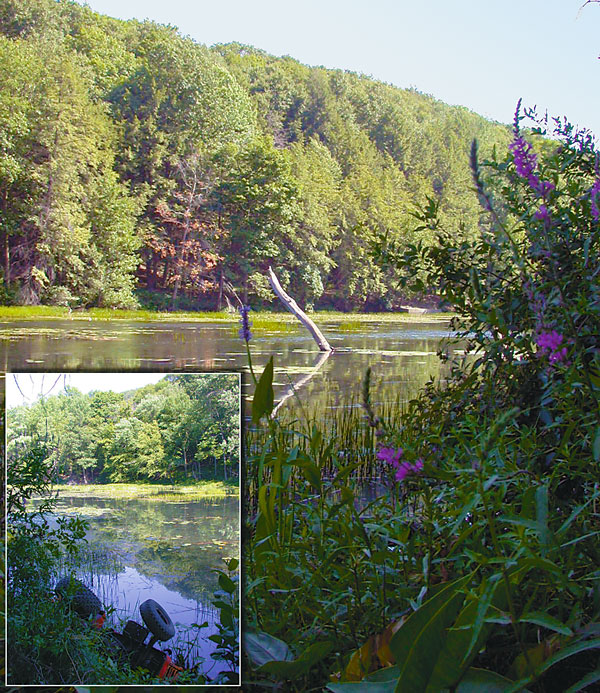
The river is not what it might be. But neither is it what it was only a decade ago, and it is a long, long way from the industrial sewer it was when its valley was all about moving iron and coal. With some help from its friends the river has a bright future.
The river rolls out of Lake Madonna in Sparta Township, Sussex County, and tumbles southeast toward the Morris County line. It passes through the Sparta Mountain Wildlife Management Area, crosses into Morris County, and then turns sharply south. If you like your rivers pristine and untouched to the extent that any piece of nature anywhere is pristine and untouched this is your stretch of river. The Rockaway flows through public land here, and though it isn't always easy to reach, it's worth reaching. This, fishermen say, is a good place for trout and for smallmouth bass.
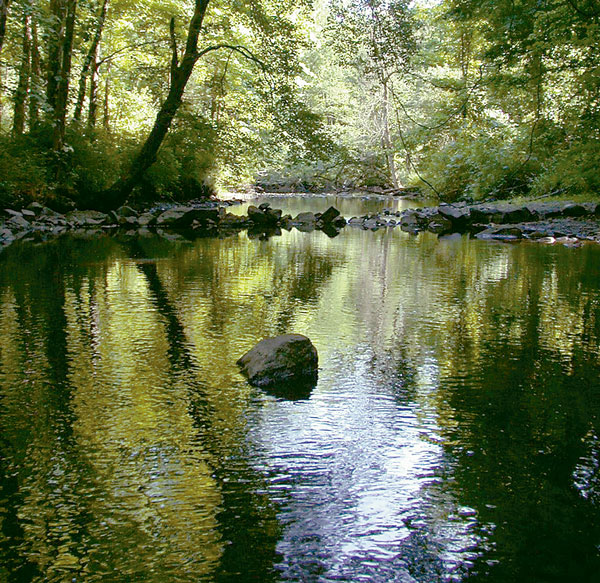
After the Rockaway turns to the south, it tumbles through a series of small lakes and ponds, fed along the way by several brooks and creeks. Many of the lakes and ponds have private communities built around them, and access to the river along their banks is limited. Berkshire Valley Road runs parallel to the river, first on its eastern bank, then on its western bank, and there are spots where it's possible to turn off the road and walk through the bushes to the river. But those spots aren't easy to see unless you're really looking for them, which may be why the river, though no longer untouched, is still fairly pristine in this stretch.
You might call this the Forest Gump stretch of the Rockaway River. Pull off the Berkshire Valley Road (aka Route 699) at any of the many turn-outs, and you never know what you're gonna get.
You might find a short, steep footpath that leads you into a green glade cut by fast water. Or you might find a large dirt parking area, from which a trail leads into dense woods. We took such a trail, just south of the Dover-Milton Road, and the woods quickly closed over us. We thought, as we followed the trail and the sounds of traffic grew fainter, that this access to the river was a treasure, closed in by greenery as it was. Then it occurred to us that someone on an all-terrain vehicle might find the trail tempting. And sure enough, at the bottom of the trail, on its back and leaking gasoline, is a rusted all-terrain vehicle. The trail leading along the water is covered with signs saying that the Morris County Parks Commission patrols this land and also covered with plastic and Styrofoam litter.
But this is also a beautiful spot. The river widens behind an old dam here to form Oak Ridge Lake. The lake is covered with water lilies and critters that live on and under water lilies frogs, turtles, and apparently, lots of fish, which rose continually on the midsummer day we visited to take surface insects. The view across the lake about 150 yards wide is of hills covered in oak, beech, birch, and maple, which, in the fall, go entirely to glory.
For the people who lived and worked in this valley in the 19th century, the Rockaway was a divinely installed tool for moving iron ore and coal between Pennsylvania and New York, and for powering the forges and furnaces that refined that iron into everything from railroad ties to nails. The river, like the people, was there to work. And they worked it hard.
The Rockaway River enters the Industrial Revolution at Wharton, where it takes a sharp bend to the east. Here, it is joined by what is left of the Morris Canal, which once lifted boats loaded with coal and ore from Phillipsburg, on the Delaware in Warren County, over a 1,600-foot-hump at Lake Hopatcong, and eventually to Jersey City.
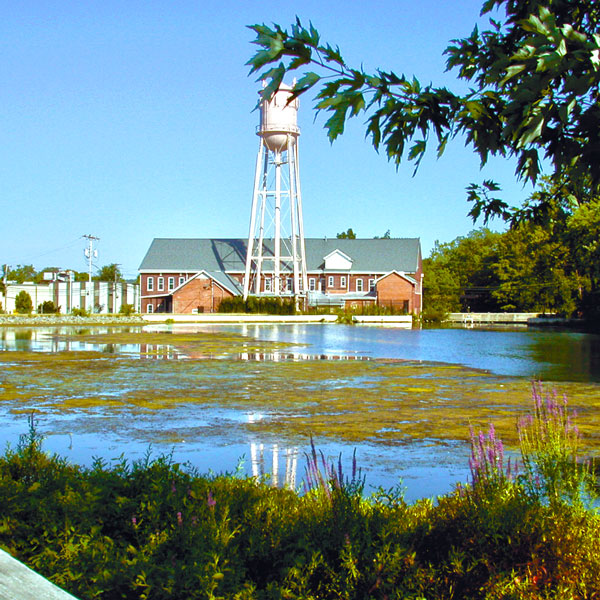
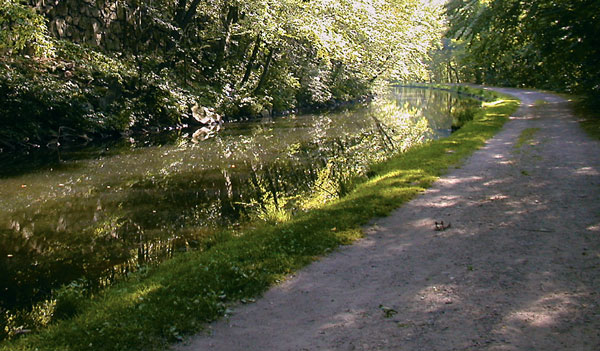
Wharton, like many of its neighbors, started as a mining and forging community, and was originally called Port Oram. Charles Hoff built the Washington Forge there in 1795. His forge turned iron ore into iron bars, which were then transported to the rolling mills in Dover, just down-river. And where did the ore come from? Originally, from shallow pits on the south bank of the river, which also provided the power for the forge. The shallow pits eventually became one big pit, which is about all that remains of the enterprise today. It's called Washington Forge Pond.
The Morris Canal, completed in 1831, was a temporarily elegant solution for the transportation of all that ore, and coal, and forged iron. It lifted and lowered its cargo between Phillipsburg and Jersey City with a series of locks and planes. The planes had cars on tracks, into which boats were loaded, and then winched up or down the planes. Towns all along the old canal have streets called Plane, which usually are the sites of the planes themselves or which originally led to the planes.
Today, in Wharton, the river angles peaceably through town to Hugh Force Park, just off South Central Avenue. The canal, just to its north and about ten feet higher than the river, is full of water and kept moving (very slowly) by a feeder stream from the river. Access is easy, and a well-groomed path leads you along with the canal on your right and the river on your left. The river is full of little rapids and pools here, and lined with hardwood trees. Sitting on one of those boulders in the fall, with or without a fishing rod in your hand, is as peaceful, pleasant, and cheap a date as a person could wish for.
In Dover, the river enters hard times. Here the river is confined to a concrete channel as it enters Dover and swings past the New Jersey Department of Labor and under Route 46, and dribbles, straight and narrow, parallel to and a block north of Blackwell Street, which is Dover's main drag.
Dover which, along with Boonton, was one of the main iron processing centers in the area in the first half of the 19th century, was once home to a Dickensian landscape of forges, mills and furnaces, manned by hungry European immigrants, Dover is now home to thousands of new immigrants, mainly from Latin America. You can follow the anthropology of the town by the cuisine offered on Blackwell Street a restaurant that served once served only Colombian serves Mexican food today. And around the corner, you may find an establishment offering Peruvian food. Blackwell Street is full of life, full of commerce, lit up like a Christmas tree all year long. Things are happening on Blackwell Street.
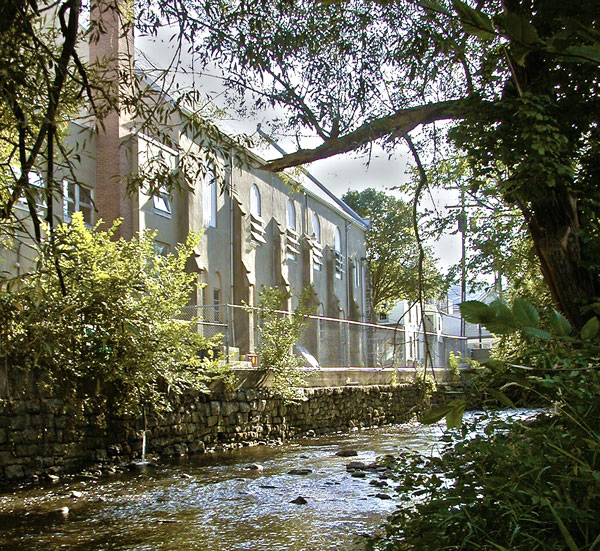
A coalition of environmental groups and government officials including Dover's government --secured funding in the late 1990s for a "greenway" along the river in Dover. That greenway runs from Mercer Street east along the north bank of the river for about five blocks a wood chip path punctuated by park benches and some picnic tables. The view from these tables is of the river about 25 to 30 feet wide and the backsides of businesses on Blackwell Street. The river water is clear, litter or not. The greenery is healthy, but unkempt, which means that poison ivy is taking the greenway over.
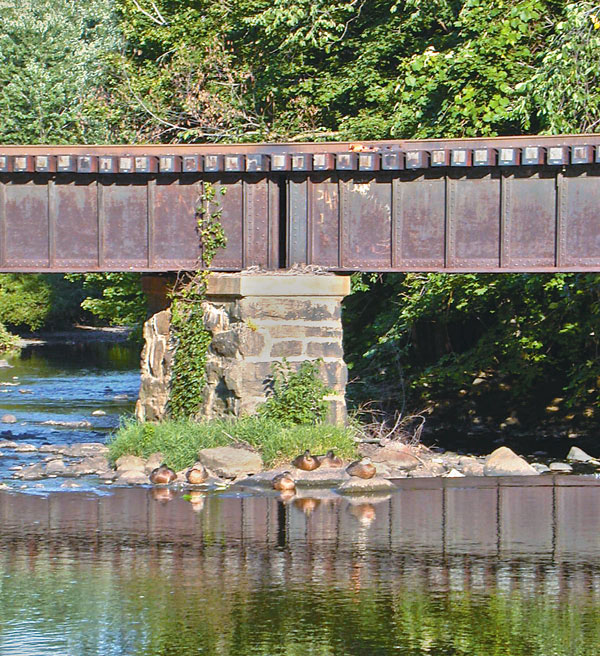
Next door, in the Borough of Rockaway, the river is less filled with debris, but harder to reach through most of town. It flows right past the backyards of dozens of residents an issue during floods, which are fairly frequent in this valley. But along Jackson Avenue, the river widens behind an old milldam and the borough has laid out a simple park a stretch of grass with picnic tables and benches, but with no trees.
In Denville, the river moves upscale, with a corresponding improvement in its vistas. Passing through town, the Rockaway goes through two parks, the most recently renovated of which is McCarter Park. Despite being located right across the street from a fast food establishment, the river is free of litter, and so is the park. You have to look for this placid little park, but it's clearly marked, at the western end of Broadway, about a mile after you leave Exit 38 on Interstate 80. It's green, and peaceful, and the river supports several species of fish here, including, of all things, carp.
If ever a river needed a friend, the Rockaway is that river. And it has friends, formally organized into the Friends of the Rockaway River in 1990. The river is their river; they feel connected to every rock, riffle, and waterfall along its forty miles, and to every frog, trout, snake, turtle, fish, hawk and heron that hops, swims, slithers, or crawls in it or flies over it. And, he insists, there's a lot more hopping, swimming, and slithering going on now than there was in the recent past.
Part of this improvement has to do with the death of the iron and coal industries that the river once powered and that once polluted the river. Part of it also has to do with the efforts of state and federal agencies to monitor the quality of the water along its length. There is also a coalition of thirteen municipalities (including Jersey City, whose drinking water comes from a reservoir along the Rockaway in Montville Township) called the Rockaway River Watershed Cabinet. The cabinet concentrates on water quality. In 2000, the Cabinet developed a watershed management plan to protect and restore stream corridors throughout the watershed not just the Rockaway, but its many small tributaries.
In Boonton, the river bounds through a gorge full of enormous boulders and little pools. A path leads between the river and the backsides of the town's apartment buildings many of which, though their residents may not know it, rest on the foundation of old iron works and shops.
A masonry outbuilding whose foundation extends below the level of the yard to where we walk is original, early 19th century. As you walk along here, you can see the stonework underlying these modern buildings, you can see lots of artifacts from the iron era.
Near the line between the Town of Boonton and Boonton Township, a bridge over the river points downstream to what looks like the midstream pier of an old bridge. The pier seems to be subsiding backwards into the river, and it's flying an American flag. That's the old mule bridge. Mules were used to haul boats on the canal, but then you had to get the mules across the river, so they could pick up the boats at the other end of the plane.
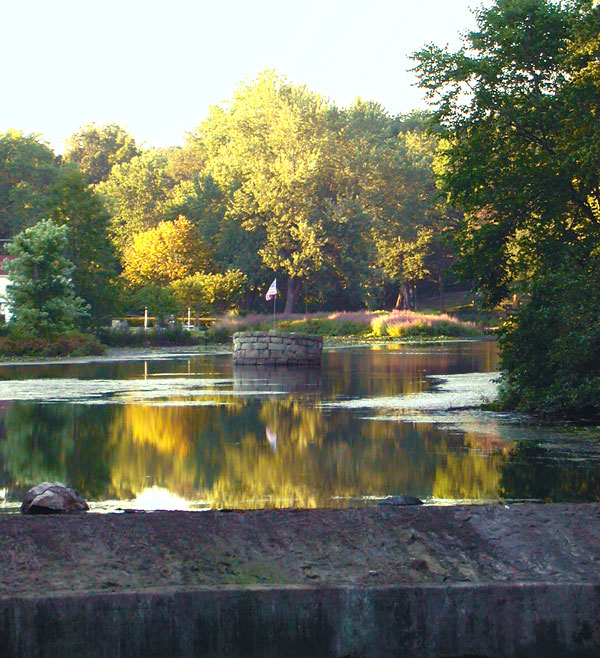
Walking through Grace Lord Park, behind the municipal garage and uphill from the police pistol range, a steep street leads up to downtown Boonton. This is Plane Street, and, indeed, it isn't hard to imagine large canal boats being winched up and down this long straight street.
The Friends, and other groups like the Friends, have been instrumental in keeping interest in the river alive. With the aid of grants from several foundations, they sponsored a study of the river, its problems and potential, called The Rockaway River and Its Treasured Resources: Visions and Strategies for Their Recovery. The study called for cleaning up the river where it needed it, for increasing public access to it, and for developing its waterfront communities in a way that would both bring people to the Rockaway and awaken in them a determination to take care of it. In Dover, for example, the Visions and Strategies plan called for the creation of a much longer greenway than now exists, and for the creation, along the Bassett Highway on the west end of town, a mixture of restaurants, shops and offices in existing and new buildings.
Money wouldn't hurt, but volunteers might be even more help, at least in the short run. There never seems to be an end to the task of taking litter out of the river and off its banks. Part of the problem is that litter comes from upstream, especially after a big rain, when all sorts of stuff washes down. But even as a small pile of plastic litter deposited on a boulder in the last high water violates the river as it pounds over the rocks, through the gorge, it is still a beautiful thing to see.
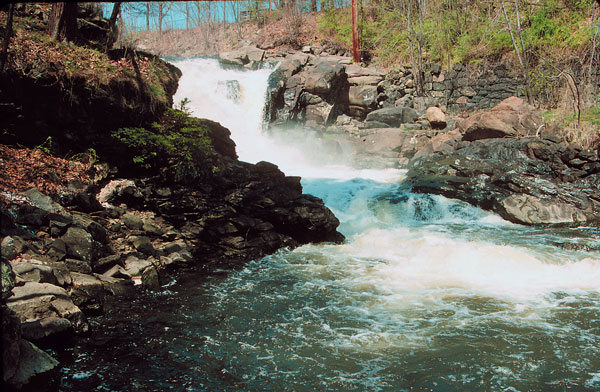
Rob Grow, owner of Potbelly’s Riverside Café located on the river in Rockaway Borough, sponsors a spring AND fall river cleanup, pulling debris from the river itself, its banks and occasionally even farther inland after spring floods leave debris behind after the water recedes. Rob gets financial support from the town’s businessmen, his customers, and local fishermen and other outdoor enthusiasts. his volunteers have included Little League teams, scout troops and packs, groups of school teachers and his work has also attracted the attention of Trout Unlimited the past few years. Rob also brings attention to the river by sponsoring a season-long trout fishing contest, again relying a lot of donations to purchase between 25-30 three-pound rainbow that are stocked in the river before Opening Day. ~Bob Decker
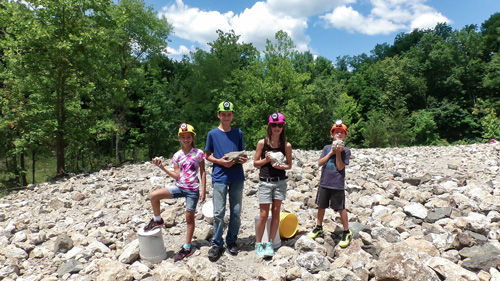
“The Fluorescent Mineral Capitol of the World" Fluorescent, local & worldwide minerals, fossils, artifacts, two-level mine replica.
Dedicated to preserving the heritage and history of the railroads of New Jersey through the restoration, preservation, interpretation and operation of historic railroad equipment and artifacts, the museum is open Sundays, April thru October.
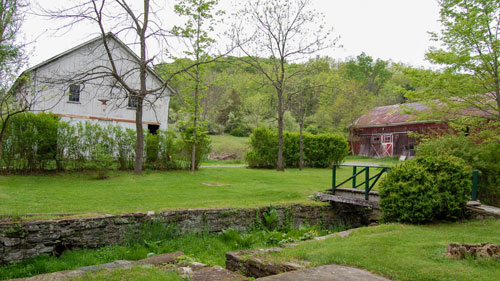
Peters Valley shares the experience of the American Craft Movement with interactive learning through a series of workshops. A shop and gallery showcases the contemporary craft of residents and other talented artists at the Crafts Center... ceramics, glass, jewelry, wood and more in a beautiful natural setting. Open year round.
Even today, if you needed a natural hideout—a really good one—Jonathan’s Woods could work.